By Robin McKelvie
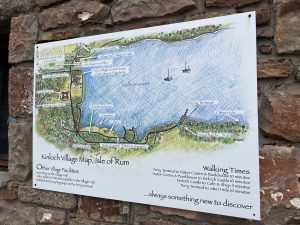
I’m writing this on the Lucy Mary, a small ship dragging me away across the surf from Rum. This remarkable Hebridean island is never an easy place to leave: the largest and most dramatic of the Small Isles is certainly no poor cousin to big sister Skye just over the water. I’d heard about the island shop being up for sale, one of the families who moved in as part of the Lockdown competition to live on Rum moving on and of a bid to turn Kinloch Castle into a luxury playground tied into hunting and fishing. So it was with some trepidation that I sailed into Loch Scresort.
The name Scresort ties into Rum’s Viking heritage, as does the highest peak of Askival and the rum of the same name that now hails from the island. A sweep of west coast clans also tie into the story of a Scottish island where evidence of man dates back to Mesolithic times. The nineteenth century brought baleful Clearances that saw the majority of the almost 500 residents swept off the land, often with soul-crushing harshness. My first stop is an old cleared township – one of what once were 40-50 across Rum – that lies near the excellent Nature Scot otter hide.
The Clearances weren’t the only dark days in Rum’s recent history. George Bullough may have renamed the island Rhum to counter the alcohol connotations, but his Rum became known as the ‘Forbidden Isle’ with unauthorised visitors not welcome. His lair was the surreal Kinloch Castle, an Edwardian spaceship plonked down on Rum, hewn from imported Arran red sandstone, whose gardens were fertilised with the finest Ayrshire soils and whose ponds were filled with confused turtles and alligators. The staff too were fetishised into having to wear kilts. We won’t go into the ‘legendary’ parties.
George Bullough died in 1939 and Lady Bullough lived on part-time here until her death in 1967. Rum was sold to Nature Scot and Kinloch Castle also served as a unique luxury hotel before becoming surely the grandest youth hostel in Scotland. The cost of the upkeep proved crippling for both ventures and today Kinloch Castle is crumbling into a dishonourable old age.
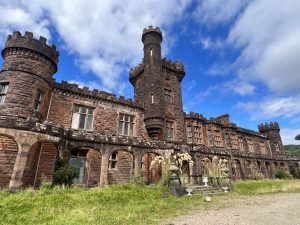
Recently a millionaire who wanted to turn Kinloch Castle back into a hotel housing his hunting, shooting and fishing guests tried to buy it for the £1 asking price – it is estimated it will take at least £20m to bring it back to life. Some locals were less than convinced how the community and landownership issues would weave into his plans. I had my own concerns after seeing how well community ownership can work on neighbouring Eigg.
After peering through the windows – be very careful about getting too close as the site is a definite health hazard and is marked as such – to make out the taxidermy sea eagle and period furniture I made for the village of Kinloch with my lingering trepidation intact. I was soon, though, told that the latest ownership bid had fallen through and by the wave of relief I felt here it appears to have been a popular result for the community. The problem of Kinloch Castle may not have been solved, but as one local put it, “Rum has dodged another bullet.”
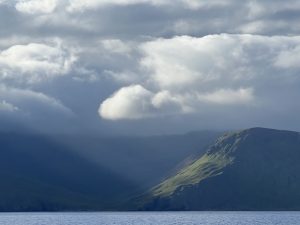
My worries about the local shop eased too. It was put up for sale earlier this year and a sign at the pier had warned me it was currently closed and looked to have very limited opening hours. Instead I found Isle of Rum General Store open with new owner Stuart McKie beaming across the counter of his new well-stocked shop. “It’s a sheer joy and privilege to come here and run a shop that is so important for the island community,” he beamed. With Stuart’s positive attitude, his plans to bring in Glen Lyon Coffee Roasters and start offering light meals, there are serious green shoots for Rum.
That optimism spreads to the literal rum too. The local tipple – whose owners come to Rum to forage for the botanicals they weave their way into Rum’s Askival rum – was sold out during my visit. Stuart assured me they would be getting some more in soon. “Being too popular is a good problem to have,” said Stuart. My other fear about the abandoned new residential house on Rum was eased too, as Stuart has just moved in there with his partner Jennifer Thompson, bringing Rum’s population up to 34.
For Stuart moving to this Scottish island was a no brainer – “I have been in love with Rum for much of my life,” he smiled as we had coffee in the two armchairs that welcome shoppers. “The first time I came to Rum I was hooked. It is so peaceful here, just so beautiful, but there is a real living community too. And that community is at the heart of everything, as it should be on a Scottish island.”
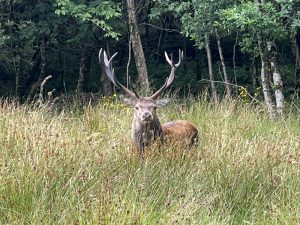
I agree with Stuart on all of that. Rum’s beauty and peace is up there with anywhere in the Hebrides and that is saying something as this is my favourite archipelago on the planet. The info in the Scottish Islands Passport app on Rum – there is a stamping station too at the island’s bunkhouse – illuminates the amazing wildlife, including the world famous Manx shearwater colony, that castle and island’s eclectic history.
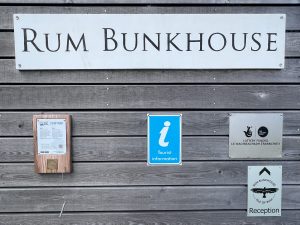
As always with Scottish Islands Passport I found little nuggets that I had not picked up on my previous half dozen visits to Rum. I knew there were a lot of deer, but not that the island is home to the Rum Deer Project, the longest running mammal survey in the world. I didn’t know that the hydroelectric scheme that powers much of Rum is the original, or that a Christian follower of St Columba holed out in a cave here for forty years, composing Gaelic tributes to the saint. A real nugget is the information about the Small Isles Games, an event that rotates between the Small Isles and is critical in bringing all the island communities together and cementing ties between them.
The second word on the Scottish Islands Passport entry on Rum is “community” and that again is utterly crucial here. The app talks of the Rum Community Trust, which was set up in 2007 so that the community had a far greater say in the running of the island, which is run by Nature Scot as a National Nature Reserve. I’m leaving now relieved that the community here on Rum has managed to navigate through yet more tricky waters to steer a community-focussed course into a future that no doubt will have its own challenges, but at least it is an island that is forbidden no longer.


